< Previous
THE POET and THE PASTOR:
Memorials to two local non-conformists
Part 2. The Congregationalist: ‘A man of the highest order’
By Stephen Best
(Part One gave an account of Henry Hogg, a Nottingham poet, solicitor, and Methodist lay worker, who devoted much of his short life to the service of the poor of 19th century Sneinton.)
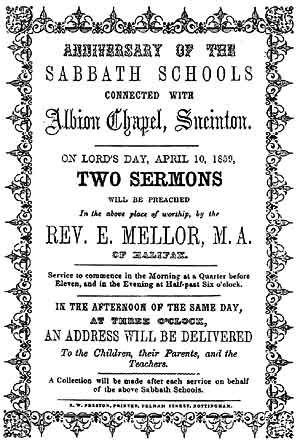
IT WAS SUGGESTED at the beginning of this article that the name of Henry Hogg is quite unknown nowadays in the Sneinton for which he worked so long and selflessly. Not far away from Hogg's gravestone in the. General Cemetery, a very striking memorial commemorates another notable Sneinton nonconformist personality. As also observed earlier, this second man is not yet totally forgotten - indeed, a letter in a very recent Sneinton Magazine mentioned his name.
And if an unusual name is harder to forget than an everyday one, then the Rev. Speight Auty came equipped with a tidy hold on immortality. His arrival in Sneinton in January 1894 heralded a long-awaited revival in the life of the Albion Congregational Chapel.
The Albion story began in 1842, when Castle Gate Congregational Church determined to set up a branch Sunday School in Sneinton, which, at this date, had over 7,000 residents living in some 1,600 houses. To serve this population were only two places of worship: the parish church, newly rebuilt in 1839, and the Methodist chapel in Byron Street referred to in Part One of this account.
The Castle Gate authorities acquired single-storey premises in Upper Eldon Street, (in which street Henry Hogg was to open his mission room over thirty years later,) and the Sunday School flourished so well here that an extra storey was added to the building after a couple of years. One of its first teachers was William Crosbie, a Scot who had come to Sneinton to serve an apprenticeship with his uncle, William Scott Davidson, a travelling draper of Haywood Street. In time Crosbie purchased his uncle's business, but eventually sold it and left to study for the ministry. He became pastor at several places, including Brighton, Derby and Park Hill, Derby Road, Nottingham.
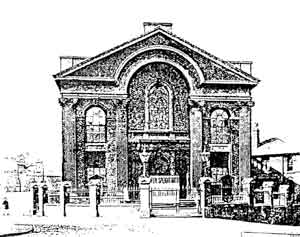 THE ALBION CHAPEL about 1905, with the Rev. Speight Auty’s name prominent on the notice board.
THE ALBION CHAPEL about 1905, with the Rev. Speight Auty’s name prominent on the notice board.The success of the Eldon Street Sunday School led to a meeting of local Congregationalists, to consider the building of a new chapel in Sneinton. They met in the Fletcher Gate warehouse of I. & R. Morley, with the Nottingham head of the firm, Arthur Morley of Sneinton Manor House, presiding.
Several possible sites for the chapel were discussed, the choice eventually falling on a plot just to the south of Sneinton Road. On 8 October 1855 the foundation stone was laid at the moment at which the Castle Gate bicentenary service began. A handbill announcing the stone-laying recorded that the new chapel being erected at this time: 'May be regarded by such of the friends at Castle Gate as assist in the effort, as a memorial of the favours so long conferred upon themselves.'
Ten months after this, in August 1856, the chapel was opened, a number of Sneinton families contributing generously towards its building costs. The building, which is, apart from the row below Eyre Street, the sole surviving 19th century feature of Sneinton Road, was designed by Thomas Oliver junior, of Sunderland. His was among the model designs chosen by the English Congregational Chapel Building Society, 'and adapted by the architect to the site at Sneinton.' The total cost of the chapel was £5,084.
The opening service at the Albion took place, rather surprisingly, on a Thursday morning, with lengthy sermons by the Rev. Dr. Raffles of Liverpool, and the Rev. George Smith of Poplar, London; the latter was Arthur Morley’s brother-in-law. The 'highly respectable’ congregation contributed a first collection of £31.
A few weeks later forty-two members withdrew from Castle Gate Church, whose minute book noted that: 'This Church accepts, with feelings of sincere respect and kindness, the intimation that certain of its members have deemed it their duty to worship at Albion Chapel, Sneinton, and to constitute a distinct and separate Church in that place.' 1
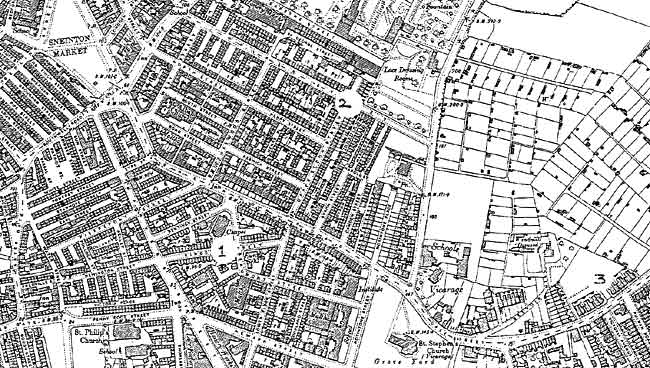 SNEINTON IN SPEIGHT AUTY’S DAY.
SNEINTON IN SPEIGHT AUTY’S DAY.1. The Albion Chapel ...2. Upper Eldon Street ... 3. Victoria Villas.
These forty-two people included some prominent local residents, including the brickmaker William Burgass of Carlton Road: the lace manufacturer Samuel Weston Moore of Belvoir Terrace: members of the family of Frederick Snelson of Sneinton Road (the local postmaster,) and the Straw family, of whom more later.
Some eminent Congregationalist clergy preached at the Albion on special occasions over the years, while a sequence of hardworking ministers held the pastorate during four decades of fluctuating fortunes. In 1870 a series of services was held in an effort to wipe out the debt on the chapel.
Samuel Morley, celebrated in recent Sneinton Magazines,2 led the subscription list with £200. This may sound a modest sum, but it represents about £9,000 in today's values.
The Albion day school was opened in 1871, and two years later a manse was built near the chapel. Shortly after taking the Thorneywood Lane mission under its wing in 1877, however, the Albion hit a very bad patch. In 1880, during an interregnum between ministers, a committee consisting of the minister of Friar Lane Chapel and a layman from each Congregational place of worship in Nottingham was set up to help the Albion make arrangements for its future. In spite of all this advice and assistance, there seems to have been little improvement, and in 1885 the minister's house was sold for £950. This sum was used towards paying off the mortgages on the chapel and schools. The same year saw the Thorneywood Lane mission returned to the care of Castle Gate, and the death of John Straw, a hosiery warehouseman who had been a deacon of the Albion since its inception, and for some time a resident of Notintone Place.
The Rev. R. Newby Golthorp, who came to Sneinton in 1887, clearly had a difficult time at the Albion, finding, 'as others had before him, that the church was not an easy one to work.' In a letter written just before resigning his pastorate in 1891, Mr Golthorp made the curiously sad and subdued observation that, under altered circumstances, he and the Albion together could yet 'accomplish much good in the neighbourhood, though perhaps not upon sensational lines.'
In such an unpromising climate, it was perhaps not surprising that it took two years to find a new man for the Albion pastorate, and by 1894, when Mr Auty began his ministry in Sneinton, membership had fallen to fifty-nine. The new minister had much to do.
Speight Auty was born in 1853 at Batley, in the West Riding of Yorkshire. He entered the textile trade, the staple industry of the district, but in his late twenties gave up a career in cloth manufacturing to become a minister. It was now that he made an early acquaintance with Nottingham, studying at the Congregational Institute in Forest Road, under its founder and principal, the Rev. Dr John Brown Paton. The Institute occupied the building at the corner of Forest Road and Mount Hooton Road now devoted to the welfare of the deaf. After ordination in Nottingham, Auty returned to Yorkshire, serving for seven years as minister at Norristhorpe, near Heckmondwike, only a couple of miles from his birthplace. His next pastorate was on the very edge of that county, at South Stockton, Thornaby, on the Yorkshire bank of the Tees. Here he stayed for two years before coming to Sneinton.
The Albion first heard of Auty in March 1893, when the Rev. J.A. Mitchell of Friar Lane Chapel strongly recommended him as a suitable minister for Sneinton. Mr Auty subsequently came to see the Albion and its neighbourhood for himself, and made a great impression on its members. In August they formally invited him to take up the pastorate, and following his acceptance, Auty was welcomed to Sneinton at a chapel meeting on 13 November 1893.
If the Rev. Speight Auty had any illusions about the task confronting him at the Albion, they would have been dispelled on his first Sunday morning here, when a congregation of 23 adults and 13 children were present to hear him preach - this in a building which seated 800. The new minister's first self-imposed task was to understand the problems under which the Albion laboured, and then assess the chapel’s potential. Almost immediately, things began to improve. The membership, 'sadly reduced in numbers and in temporal resources,' grew again, and Auty, while reviving some old church organisations, also started new ones.
After two years of his ministry the Albion accounts had recovered to a small deficit of £1.10s.7d, while the chapel school was over £7 in credit. So well was the Albion faring that the chapel invited the County Union to hold its 1897 annual meetings there. These duly took place and were considered very successful. In 1899 the Albion set out to raise 500 guineas for new schoolrooms, and exceeded this target by over £140.
Speight Auty recovered from a long and severe illness late in 1901, preaching the Sunday School anniversary sermons for the ninth successive year. By the time that a history of the Congregational Church in Nottingham was published in 1905, its author was able to write that: 'On 7th January, 1894, the present pastor, the Rev. Speight Auty, commenced his labours. From that time there has been no turning back... Under the leadership of Mr Auty, Albion Church has won a position of great influence in one of the most needy districts of the city.' 3
In 1893, before Auty's arrival, just two services were held at the Albion each week, on Sunday morning and evening. After a decade of Speight Auty's ministry the number of services had doubled, the added ones being conducted on Sunday afternoon and Wednesday evening. This last- mentioned did not begin until 8 pm, a reflection, no doubt, on the length of the typical Sneinton working day. Under Auty the Albion building had seen a number of improvements, including a new organ and organ gallery, a new incandescent lighting system, and a thorough renovation of the chapel interior. The philanthropist Andrew Carnegie, better known for his munificent support of public libraries, put up half the cost of the organ, £250.
The organ was inaugurated in February 1905, with a recital by Sir Walter Parratt, organist of St George's Chapel, Windsor. Parratt, who in 1908 became Professor of Music at Oxford University, was, like the minister, a native of the West Riding. He was born at Huddersfield, about nine miles away from Auty's Batley.
By 1907, membership of the chapel had risen to 226, and there were amost 400 scholars in the Sunday School.4 It was little wonder that The Sneinton Almanack and Chronicle of that year considered that Mr Auty was maintaining the best traditions of the Chapel, and was very popular among his congregation.
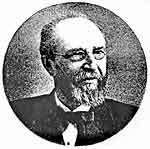 WILLIAM STRAW, for nearly half a century a worker at the Albion Chapel.
WILLIAM STRAW, for nearly half a century a worker at the Albion Chapel.For the first ten years of his service at the Albion Auty had enjoyed the staunch help of William Straw, who lived latterly at 3 Notintone Place (the house in which George Green died in 1841.) Straw, whose father John has already been mentioned, had been associated with Albion Chapel since its opening, a deacon for 30 years, and for almost as long a member of Nottingham Sunday School Union. In turn treasurer and secretary of the chapel, this veteran accountant, house and insurance agent died in 1905, a few days after the first recital on the new organ. William Straw was liked and respected by the people of Sneinton notwithstanding his official capacity of Income Tax collector.
In time the Rev. Speight Auty was elected chairman of Nottinghamshire Congregational Union; he had become known in the Church particularly for his vigorous temperance work and interest in young people. He held a remarkable record in the latter field, leading a young people's meeting every Thursday for 25 years without missing a single one. Mr Auty was, as natural in a teetotal nonconformist, a staunch Liberal. Speight Auty was not afraid to make public his political beliefs, and was a frequent speaker in the Liberal cause at public meetings.
This devoted minister was still in harness at the age of 67 after the Great War, and his death occurred unexpectedly after a day spent, as usual, on chapel business. The Nottingham Guardian of Saturday, 4 December 1920 reported that: 'Mr Auty took part in a bazaar on Thursday, and feeling unwell afterwards retired to bed early. There he died about midnight... He was 67, an active politician and a strong Liberal.'
The Nottingham Journal and Express, which shared the dead man's political convictions, gave a rather fuller account. 'We regret to announce the sudden death of the Rev. Speight Auty at his home, 2, Victoria Villas, Sneinton Dale, Nottingham, on Thursday. Mr Auty, who has been the minister of the Albion Congregational Church, Sneinton Road, for 27 years, took part in 'The Winter Retreat' held at that church. He left the bazaar at 10pm., and, feeling unwell, retired as soon as he returned home. A few minutes after midnight he was dead. He had not been well for some time, particularly during the last three weeks. The cause of his death is not known at present, but it is attributed to heart failure.'
The report referred to Mr Auty's public speaking on behalf of the Liberal Party, and also noted that he was 'affectionately spoken of as the Bishop of Sneinton.' One cannot help feeling that the Rev. and Hon. Robert Dalrymple, vicar of Sneinton during most of Speight Auty’s time at the Albion, would not have been amused at a nonconformist, however distinguished, being so nicknamed.
A further Liberal influence on Auty was touched upon: 'He had no hobby but work, believing, with Gladstone, that a change of work was a rest. He had a great sense of humour and a cheerful temperament.'
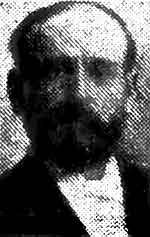 THE REV. SPEIGHT AUTY: a photograph from the Nottm Journal and Express accompanying news of his death.
THE REV. SPEIGHT AUTY: a photograph from the Nottm Journal and Express accompanying news of his death.Sadly, the only photograph of Mr Auty that I have been able to find gives little hint of these engaging traits. A fuzzy newspaper picture, little bigger than a postage stamp, it shows only that the minister possessed a balding forehead, a pair of deep-set eyes, and a dark beard and moustache.
Auty had lived at Victoria Villas, Sneinton Dale, throughout his Sneinton ministry, so the Albion had always been only seven or eight minutes' leisurely walk from his home. His residence at the Villas was divided almost equally between no. 8, now 49 Sneinton Dale, and no. 2, now number 37, to which he moved about 1909. His earliest entry in local street directories called him an 'Evangelist,' but later ones described him more precisely as 'Congregational.'
Victoria Villas were built about 1880, being renumbered as 35-57 Sneinton Dale some forty years later. This row of tall, handsome, semi-detached houses which now flanks the entrance to Holroyd Avenue, was for several decades home to a number of well-known local professional and business people. Among those who lived there during Speight Auty’s time were a couple of physicians: an architect: and a family of musicians and music teachers. The brush manufacturer, poet and artist William Kiddier, was also for a year or two a neighbour of Auty here.5
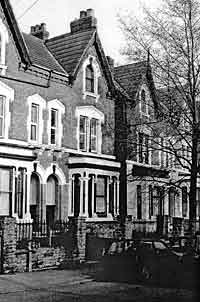 37 SNEINTON DALE (formerly no. 2 Victoria Villas, ) where Speight Auty died in 1920. (Photo: Stephen Best).
37 SNEINTON DALE (formerly no. 2 Victoria Villas, ) where Speight Auty died in 1920. (Photo: Stephen Best).Victoria Villas was, in addition, a veritable clerical stronghold. In the 1880s, before Mr Auty's arrival, the Revs. R.N.B. Davis, W.W.C. Baker, and W.G. Spearing, curates at St Stephen's church, all lived at number five. Auty's contemporaries in Victoria Villas included at least four more St Stephen's curates, together with assistant clergy of St Alban’s, Sneinton, and St Philip's, Pennyfoot Street. Another Villas resident, and a near neighbour of Mr Auty, was the Rev. F.C. Pheasant, organising secretary of the Additional Curates Society. One cannot help thinking, with the greatest possible respect, that Mr Pheasant did not have to go far from his own front door to find a goodly number of additional curates.
Another, highly influential, Sneinton clergyman lived for a while at Victoria Villas. This was the Rev. J.H. Taylor, who was in rooms here soon after his arrival in Nottingham in 1906 as chaplain of St Christopher's Mission Chapel in Colwick Road. When, a few years later, the permanent St Christopher’s parish church was built, Mr Taylor moved to the splendid new vicarage at the top of Sneinton Boulevard.
Resident clergy are nowadays quite unknown in Victoria Villas, and are becoming unhappily thin on the ground throughout the whole of Sneinton. Indeed, it seems that if the Diocese of Southwell has its way, this marked decline in the number of local ministers who actually live in Sneinton will continue, to the great detriment of the community.
The funeral of the Rev. Speight Auty took place on 7 December 1920. A service was held in the Albion Chapel, followed by burial in the General Cemetery. The Rev. A.R. Henderson, who had left Castle Gate Church for Wolverhampton only a year before, conducted both parts of the ceremony. Among family mourners was Mr and Mrs Auty’s only son George, who three weeks before his father's death had been ordained in High. Wycombe. There was a large attendance of Congregational clergy from Nottingham and the surrounding area, together with representatives of local Liberal Associations. A local United Methodist minister, the Rev. T.E. Clarke of Sneinton Hollows, was also among those present, but other Sneinton clergy were unhappily and unaccountably absent, or went unmentioned in press reports.
After the singing of ’For all the Saints’ at the Albion service, Mr Henderson paid a tribute to 'the unique personality of the deceased, and characterised him as a man made in a mould of his own... with a burning enthusiasm, which difficulties could not quench, nor time destroy. ’
Henderson went on to say that 'It had needed a man of the highest order to take the pastorate of that church, the empty pews of which were at one time a challenge to him to put his gospel to the proof. He became the father of the poor, thedowncast, and the fallen, and of him it might literally be said that 'he went about doing good.' His conviction was that the gospel was the one unfailing remedy for the ills of mankind.'
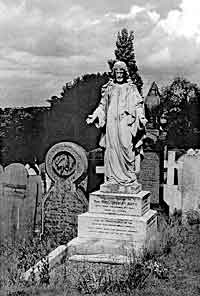 SPEIGHT AUTY'S MEMORIAL in the General Cemetery, Nottingham. (Photo: Stephen Best).
SPEIGHT AUTY'S MEMORIAL in the General Cemetery, Nottingham. (Photo: Stephen Best).In his will Mr Auty left effects amounting to £659, a comfortable enough sum for 1920, but by no means great riches. His widow Sarah was granted probate. Speight Auty lies buried beneath one of the most striking memorials in the General Cemetery. It stands next to the main footpath through the cemetery, and many people must have noticed it in passing. A large figure of the Good Shepherd stands on a plinth, with an inscription recording that the Rev. Speight Auty, who died on 3 December 1920 (not the 2nd, as reported in some newspapers), was 'For 27 years Pastor of the Albion Congregational Church.' The memorial also commemorates 'Sarah, wife of Rev. Speight Auty, aged 74 years. Reunited Sunday morning April 21st 1929,' and a seven- year-old grandson.
Auty's gravestone is rather more than a hundred yards distant from Henry Hogg's resting place. He does, however, have as his immediate neighbour here yet another worthy man, whose headstone is distinguished by a dragoon's helmet in carved relief. Though he was neither a native nor a resident of Sneinton, we cannot ignore this last-minute player on our stage. Frederick Attenborough, a former private in the army, had died in 1869, leaving the astonishing sum of over £4,000 to the General Hospital, where his life had once been saved. Did any other private soldier in the Victorian Army amass such an amount? Attenborough deserves a respectful nod as we acknowledge the good works that Henry Hogg and Speight Auty did in Sneinton. Both would certainly have approved of him, and he of them.
1 Further details may be found in A great public convenience: the early years of the Albion Chapel. Sneinton Magazine 25, Autumn 1987
2 Sneinton's hosiery dynasty: the Morleys of I. & R. Morley. Sneinton Magazine 76 & 77, Autumn 2000 & Winter 2000/1
3 A.R. Henderson. History of Castle Gate Congregational Church, Nottingham, 1655-1905. London, Clarke, 1905
4 D.L. Ritchie and J.W Russell (ed.) Transactions of the Nottingham Free Church Historical Society, 1907. Nottingham, printed by E.H. Lee. 1908
5 Brush and pen: William Kiddier and his work. Sneinton Magazine 42, Spring 1992
I am grateful to Ken Brand and Michael Brook for reading the manuscript of this article and for offering helpful suggestions. Any errors or solecisms are of course entirely my responsibility.
< Previous
